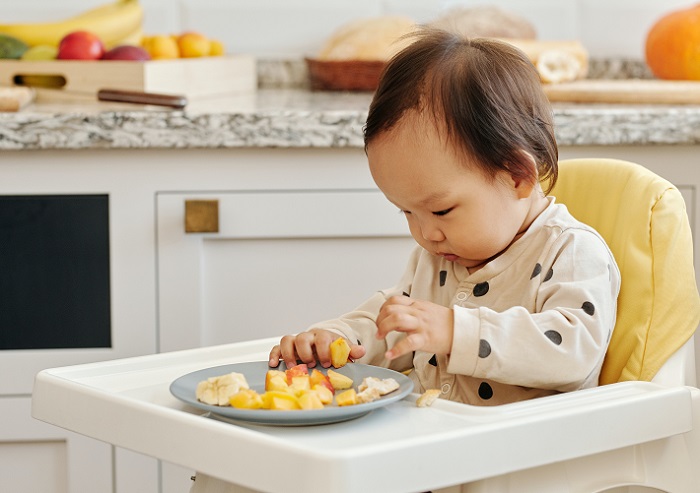
Complementary Feeding: Foundation for a healthy life
In our previous blog, we discussed the first 1000 days of life i.e., nutritional care during pregnancy and 6 months of exclusive breastfeeding i.e., the initial 460 days. Here we will discuss the next 540 days, from the child's 6 months to 2 years of age which includes the introduction of complementary foods along with breastfeeding. Let us understand why complementary feeding is considered as the foundation for a healthy life.
What is complementary feeding?
Complementary feeding is defined as giving infants food in addition to breast milk, when breast milk alone is no longer sufficient to meet nutritional requirements of the infant after 6 months of age.
It is right that "Breast milk is the best baby food". Hence, it is recommended to exclusively breast feed the child for 6 months. As the name suggests complementary feeds, compliments breast milk to fulfill the child's nutritional demand. Inappropriate feeding practices might lead to physical and brain growth faltering, micro-nutrient deficiency, malnutrition, and infectious diseases.
When we plant a seedling we ensure that it gets, proper sunlight, water and nutrition required for its development. Along with this we also add manure to enhance the growth. Similarly, a baby requires proper nourishment for his growth and development.
The majority of growth in a child happens in the first year of life. It includes a tripling of Baby's birth weight, height increases, growth and development of the brain. To support this rapid growth, a baby requires a much higher nutrient intake.
The beginning of complementary feeding is a big milestone in a child’s life. In many cultures, this day is celebrated as "Annaprashan". An ideal weaning food should be high in energy, easy to digest, semi-solid consistency, fresh, inexpensive and easy to prepare.
Benefits of complementary feeding

4 Pillars of Complementary feeding to ensure proper nutrition

Key Messages for Complementary Feeding
- It may take a while for your baby to get used to taking food from a spoon, so patience is a must. Allow them to use their fingers, even if they make a mess.
- For safety reasons always watch your baby when they are eating, to help them if they’re struggling.
- Try to provide a variety of taste. Do not encourage excessive sweet or salty food or packaged food like chips, cookies, biscuits.
- Do not offer more than a teaspoon of the food to the baby initially, gradually increase.
- Gradually introduce solid foods. Always introduce one new food at a time and continue the same for 3-4 days to look for any allergic reaction.
- Food should be cooked and served as semi-solid, along with finger foods. The baby’s plate should contain foods of various colours and textures.
- Meal-time should be fun- time for the child, play games with them. Do not use television, smartphones and computers for engaging children.
Stages of complementary feeding

Always encourage home-based complementary feeds. Commercially available complementary feed and formula milk are high in sugar content and are addictive for the child. It also leads to early incidences of chronic diseases and childhood obesity.
Instant mixes can be prepared at home by roasting and powdering combination of cereal and pulses of choice. The proportion of cereal and pulse can range from 2:1 to 3:1. You can add powdered nuts. These mixes can be kept for more than one month in air tight containers and used whenever required. Here are some examples of instant mixes and fresh recipes-
1. Wheat food mix- Roast 100 g wheat, 30 g green gram dal and 20 g deskinned groundnut separately. Grind to a fine powder. Mix all the ingredients thoroughly and store.
2. Puffed rice mix- Grind 100 g puffed rice and 30 g roasted Bengal gram. Mix all the powdered ingredients thoroughly and store.
3. Ragi Mix- Roast 100 g Ragi and 50 g Bengal gram Powder. Mix thoroughly. Store in dry airtight container.
4. Rava Payasam- Cook 30 g rava & 25 g green gram dal till soft. Cook 20 g carrot using 150 ml milk & mix with cooked dal & rava. Add 10 g jaggery & boil till it dissolves completely. Let it cool & serve.
5. Jowar Rabdi- Wash 50 g jowar and cook in 100 ml butter milk. Add 25 g of chopped spinach once jowar is cooked, continue cooking for few minutes. Add salt according to taste and ½ tsp ghee. Let it cool & serve.
6. Paushtik Khichdi- Wash and soak 50 g rice and 20 g dal for 15 minutes. Heat 1 tsp oil, add jeera and saute chopped onion 10 g, 10 g potatoes, 15 g spinach, 10 g tomatoes and spices to taste. Add soaked rice and dal. Add water and cook till soft. Serve with coriander leaves
Don’t ever force the baby to finish what you have made. If you force-feed the baby they may vomit everything out, so stop and try again next day. The first years last forever give the proper nutrition. As a parent, you have a very special opportunity to help your baby's overall development.
We at the The Basic Meals strongly believe that complementary feeding is the foundation of your child's healthy life and ensure to provide the right nutrition plans that help boost the growth and development of your child. Check out www.thebasicmeals.com for more details.
Happy parenting!

